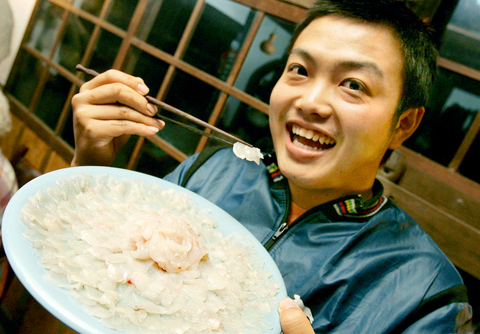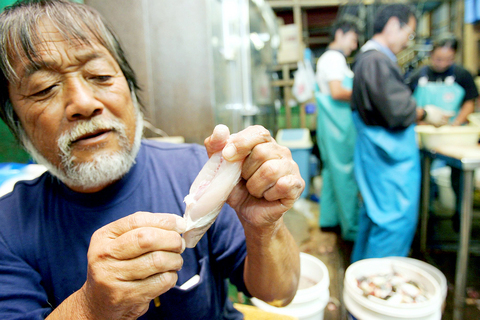Scientists in Singapore said they have uncovered the mystery of how the puffer fish survives despite the deadly poison in its body.
Research by the Institute of Molecular and Cell Biology and National University of Singapore showed the toxin, which is 20 times more deadly than cyanide, helps the fish to breed and defend itself against predators.
A process known as "evolutionary adaptation" allows it to become immune to the tetrodotoxin poison which comes from the food it eats, primarily marine life contaminated with the toxin.

PHOTO: EPA
"The scientists believe that besides helping to act as a defense against predators, tetrodotoxin resistance has allowed puffer fishes to selectively feed on tetrodotoxin-containing food items which other fish avoid."
It is also the toxin that female puffer fish use to attract their male counterparts during spawning.
The poisonous puffer fish is a highly prized delicacy in Japanese cuisine despite its lethal sting. In Japan, specialist chefs are trained in the art of removing the poison before serving the dish.

PHOTO: EPA
Black-and-white bacteria
Biologists say they have created a "living photographic film," made out of engineered intestinal bacteria, that is capable of taking high-resolution black-and-white pictures.
In a study published on Thursday in Nature, the weekly British science weekly, a team led by Christopher Voigt at the University of California at San Francisco started by extracting a light-sensing gene from a germ called a cyanobacterium.
They then stitched the gene into the cell membranes of Escherichia coli bateria, so that exposure to red light switched off a gene called lacZ that controls production of the bug's black pigment.
As a result, black-and-white images can be "stencilled" onto a mat of the engineered bacteria grown on a plate of protein-rich lab gel.
And because the screen's definition is on bacterial scale -- at up to 100 million pixels per square inch (2.5cm2) -- the resolution and tone scale are extraordinarily good.
Newton 1, Einstein 0
Albert Einstein may have made the discoveries that led to nuclear and solar power, lasers and even a physical description of space and time, but Sir Isaac Newton had a greater impact on science and mankind, according to a poll published last week.
Newton, the 17th-century English scientist most famous for describing the laws of gravity and motion, beat Einstein in two polls conducted by eminent London-based scientific academy, the Royal Society.
More than 1,300 members of the public and 345 Royal Society scientists were asked separately which famous scientist made a bigger overall contribution to science, given the state of knowledge during his time, and which made a bigger positive contribution to humankind.
Newton was the winner on all counts, though he beat the German-born Einstein by only 0.2 of a percentage point (50.1 percent to 49.9 percent) in the public poll on who made the bigger contribution to mankind.
The margin was greater among scientists: 60.9 percent for Newton and 39.1 percent for Einstein.
A roadmap for ants
Ants scouting for food place a tiny scent marker on branches that do not lead to a reward, according to a study published by Nature, the weekly British science weekly.
The pheromone acts like a "no-entry signal" to other ants, telling them not to waste their time going down that route, it says.
The discovery was made by animal scientists at Britain's University of Sheffield.
In a lab, they got a scouting colony of Pharaoh ants (Monomorium pharaonis) to explore branches that led to no reward. Paper covers were placed at the branch's forks.
The paper covers were then taken off and transferred to another set of branches. This set had already been explored by another ant colony, which found a tasty meal of sucrose at the end of the trail.
Even though the food reward was still there, ants performed a U-turn or chose another direction whenever they came across the covers.
"It provides advance warning, like human road signs situated before junctions," the authors suggest. -- agencies

As I finally slid into the warm embrace of the hot, clifftop pool, it was a serene moment of reflection. The sound of the river reflected off the cave walls, the white of our camping lights reflected off the dark, shimmering surface of the water, and I reflected on how fortunate I was to be here. After all, the beautiful walk through narrow canyons that had brought us here had been inaccessible for five years — and will be again soon. The day had started at the Huisun Forest Area (惠蓀林場), at the end of Nantou County Route 80, north and east

Specialty sandwiches loaded with the contents of an entire charcuterie board, overflowing with sauces, creams and all manner of creative add-ons, is perhaps one of the biggest global food trends of this year. From London to New York, lines form down the block for mortadella, burrata, pistachio and more stuffed between slices of fresh sourdough, rye or focaccia. To try the trend in Taipei, Munchies Mafia is for sure the spot — could this be the best sandwich in town? Carlos from Spain and Sergio from Mexico opened this spot just seven months ago. The two met working in the

Exceptions to the rule are sometimes revealing. For a brief few years, there was an emerging ideological split between the Democratic Progressive Party (DPP) and Chinese Nationalist Party (KMT) that appeared to be pushing the DPP in a direction that would be considered more liberal, and the KMT more conservative. In the previous column, “The KMT-DPP’s bureaucrat-led developmental state” (Dec. 11, page 12), we examined how Taiwan’s democratic system developed, and how both the two main parties largely accepted a similar consensus on how Taiwan should be run domestically and did not split along the left-right lines more familiar in

A six-episode, behind-the-scenes Disney+ docuseries about Taylor Swift’s Eras Tour and Rian Johnson’s third Knives Out movie, Wake Up Dead Man, are some of the new television, films, music and games headed to a device near you. Also among the streaming offerings worth your time this week: Chip and Joanna Gaines take on a big job revamping a small home in the mountains of Colorado, video gamers can skateboard through hell in Sam Eng’s Skate Story and Rob Reiner gets the band back together for Spinal Tap II: The End Continues. MOVIES ■ Rian Johnson’s third Knives Out movie, Wake Up Dead Man